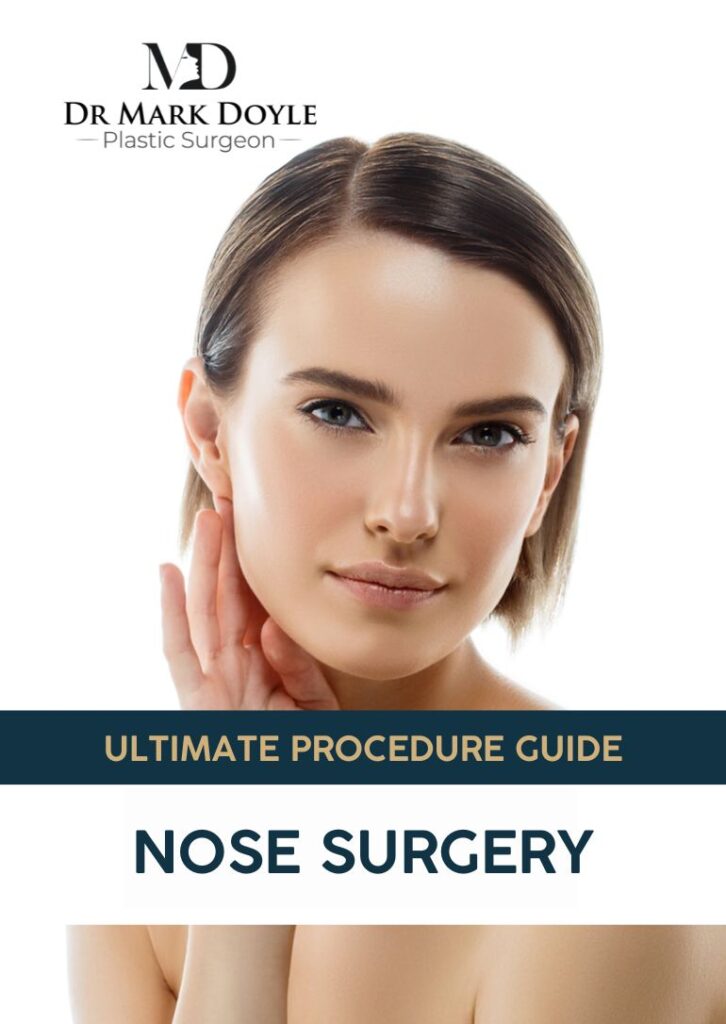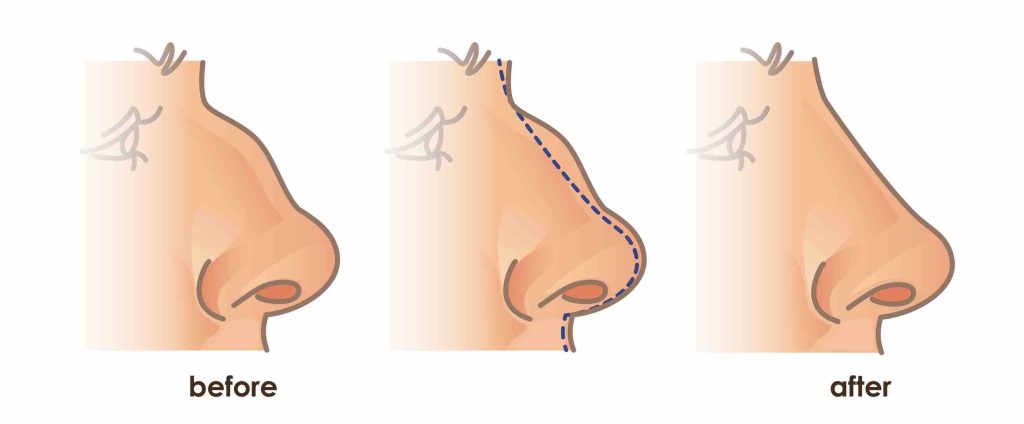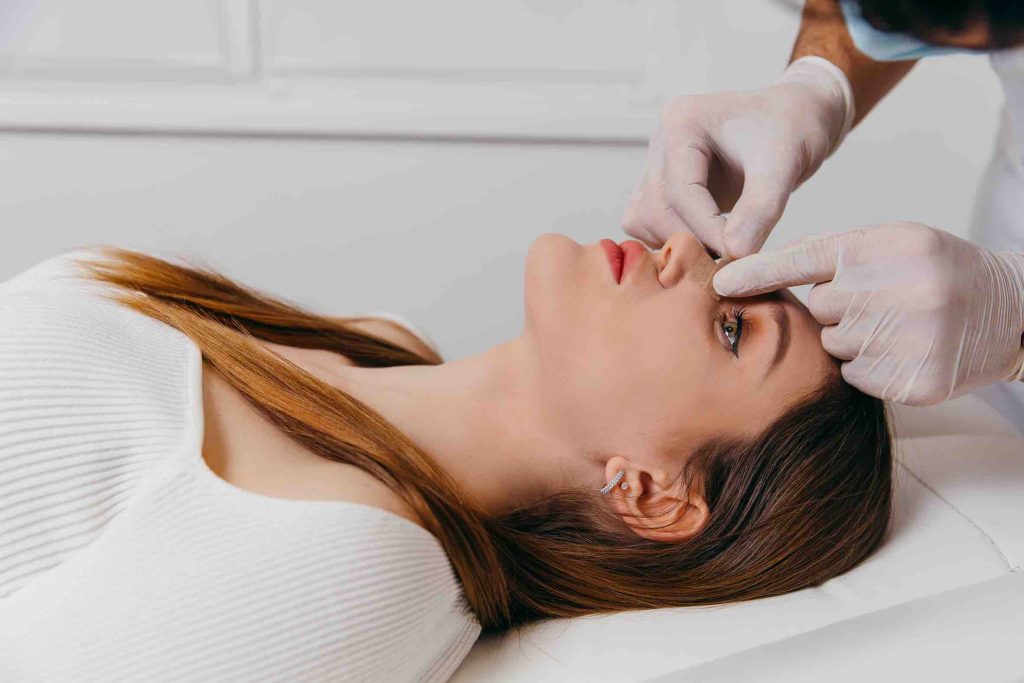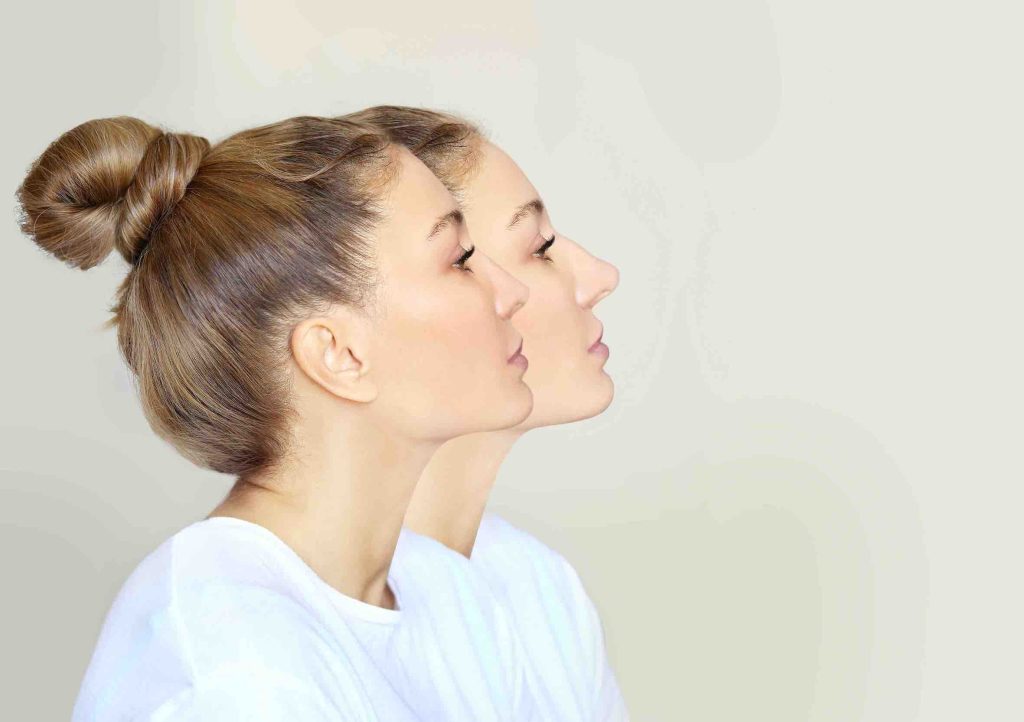There are many different types of noses out there. Nose shapes are the result of different shapes and sizes within each part of the nose. Many people have different nostrils, nose tips or nasal bridges, which make different shapes of noses. And while no two noses are the same, the various types of noses can be categorised together.
According to Israeli professor, Abraham Tamir (MD), there are 12 most common nose shapes. These include everything from a fleshy nose to an aquiline nose. His research findings are in the Journal of Craniofacial Surgery in 2011.

Rhinoplasty
Understanding the types of nose shapes is useful if you are considering a nose job or any nose shaping surgery. There are many procedures that can alter your nose based on your desired outcome. And, the parts of the nose which you would like to reshape.
Different Nose Shapes

There are a variety of nose types. And, everyone is unique. The different types of noses are the:
- Roman or Aquiline nose
- Greek nose or straight nose
- Hawk nose
- Snub nose
- Turned-up nose or celestial nose
- Straight noses
- Hooked nose
- Nubian nose
- Fleshy nose
- Bumpy nose
- Flat nose
- Bulbous nose
- Narrow nose
- Short nose
- High nose
- Round noses
Often, a person’s nose shape correlates with their ethnicity. For example, those of African descent tend to have wide and fleshy noses. Whereas, those of Caucasian descent have thinner and more delicate features.
Below are explanations of different noses, common nose shape types and who is likely to have them:
Roman Nose
A Roman nose or Aquiline nose is characterised by a prominent nasal bridge and a hooked shape. This type of nose is often seen in people of Italian descent.
Greek Nose
A Greek nose shape is similar to a straight nose, but it is more narrow and tapered at the end. This nose shape is often seen in people of Greek descent.
Hawk Nose
A hawk nose is one that is characterized by a very sharp angle. The nose appears to be hooked at the end. This type of nose is often seen in people of Middle Eastern descent.
Snub Nose
A snub nose shape is a nose that is short with a wide base and an upturned nose tip. This shape of nose is often seen in people of Asian descent.
Button Nose
A button nose is a small, upturned nose. It is called a button nose because the tip resembles the shape of a button. This nose is often considered to be cute or innocent looking.
Hooked Nose
A hooked nose is one that has a sharp angle at the bridge of the nose. This type of nose is often seen in people of Jewish or Middle Eastern descent.
Flat Nose
A flat nose is one that has a lack of definition in the bridge of the nose. This nose type is often seen in people of African or Asian descent.
Wide or Nubain Nose
A wide or Nubian nose is one that is one that has a wide bridge and nostrils. This type of nose is often seen in people of African descent.
Bulbous Nose
A bulbous nose is one that has a large, round shape. This nose shape is often seen in people of Caucasian descent.
Fleshy Nose
A fleshy nose is one that has a wide bridge and fullness in the tip of the nose. This nose is often seen in people of African descent.
What Causes Different Type of Noses
Ethnicity is the main factor that contributes to the different types of noses. However, there are other factors as well.
For example, your nasal bones and nasal cartilage determine the shape of your nose. The size and shape of these structures will determine different types of nose shapes. Additionally, the skin on your nose can also affect its appearance.
Different Part of Nose

When looking at the nose, there are 3 clear parts of the nose. This includes the upper part, the nasal dorsum, which is the bony “bridge” of the nose. The second is the middle part, the nasal septum, which is the internal bone and cartilage. And, the third is the lowest part of the nose, the nasal tip.
There are different types of noses because the size and shape of different parts of the nose vary. The following is a more detailed explanation of each part:
Nasal Bones (Dorsum)
The nasal bones are the two small, oblong bones that make up the bridge of our nose. They are located between our eyes and attach to our frontal bone (forehead). The nasal bones provide support for the overlying soft tissue and give the nose its shape.
Nasal Septum
The septum is the bone and cartilage that divides the nostrils. It is made up of a mucosa-covered bony and cartilaginous structure. Its role is to separate the left and right nostrils and help transmit the air directly to the lungs.
Nasal Tip
The nasal tip is the lowermost part of the nose. It’s made up of cartilages that provide support and give shape to the nasal tip. The alar cartilages form the nose tip and nostril shape.
Good Candidate for Nose Surgery
People consider nose surgery for one of two reasons. The first is to improve the appearance of the nose. Most commonly the reason is rhinoplasty for wide nose or to make a large nose smaller. Other cosmetic reasons include changing nose shape entirely.
The second reason people consider nose surgery is out of medical necessity. This is common if they have difficulty breathing, such as someone with a deviated septum symptoms. Or, they have suffered an injury and are seeking broken nose surgery.
Furthermore, good candidates for nose surgery are ones with:
- Wide, large or uneven nostrils
- A bulbous, swollen, or hooked nasal tip
- A large dorsal hump on the bridge of their nose (or other nose bridge types)
- A nose shape or size that doesn’t suit their face ie. a fat nose on a slim face
As well as this, they have realistic expectations about what the surgery can achieve. And, they are in good physical and mental health.
Different Types of Nose Job
There are multiple different types of nose surgery. The type of nose job will depend on your goals and what needs to be changed about your nose.
The following types of rhinoplasty address different parts of the nose. They can be done separately or together for a more dramatic result. Standard rhinoplasty is the most comprehensive cosmetic nose reshaping procedure.
Rhinoplasty

Rhinoplasty surgery addresses the nose bridge (dorsum), the nose tip and the nostrils (the alar cartilages). It can make your nose smoother, narrower, and smaller and change the angle of your nose. The most commonly requested nose shape for rhinoplasty is a slim nose or an upturned button nose.
Tip Rhinoplasty
A tip plasty only addresses the nasal tip cartilages at the very bottom of your nose. This procedure refines a large tip and doesn’t change the shape or size of the nose bridge or nostrils.
Not everyone is a good candidate for a tip nose job. Oftentimes, the tip of the nose needs to be refined but this might mean that other areas of the nose need to be worked on to create a more balanced look.
Alarplasty
An alar base reduction addresses only the nostrils (the alar cartilages). This can change their size, shape, and position. This procedure can treat wide nostrils or a wide nose. And, when done in conjunction with other types of nose jobs, it can provide a more balanced look to your newly shaped nose.
Nose Surgery : Procedure and Recovery

Procedure
Nose surgery is an outpatient procedure. This means that you won’t have to stay overnight in the hospital after your surgery. Dr Doyle always uses general anesthesia during nose job surgery. This means you will be asleep for the duration of the surgery.
During the procedure, Dr Doyle will make an incision on the columella (the area of skin between the nostrils). He will then separate the skin from the bone and cartilage beneath. Next, he will make any necessary changes to achieve the desired shape. This might involve trimming, reshaping or adding cartilage. Finally, he will close the incisions with dissolvable stitches.
Alarplasty is a little different to the above as the incisions are on the outside of the nostrils in the crease of the nose. From there, Dr Doyle will narrow the nostrils.
It takes around 1-3 hours to complete the surgery, depending on the extent of the changes being made.
Recovery
After your surgery, you will have a splint placed on your nose to help support it as it heals. You might also have packing in your nose which will be removed a few days after surgery.
There will likely be some swelling and bruising around your eyes which will gradually improve over the following weeks. You should be able to return to work after a week but you might want to wait longer if your job involves strenuous activity.
You should avoid blowing your nose and wearing glasses for at least 6 weeks as this could cause your nose to shift out of place.
FAQ

What types of noses are there?
There are many different types of noses, but some of the most common include the fleshy nose, hawk nose, bulbous nose, and aquiline nose.
Which nose shape is most common?
According to the journal article mentioned earlier, the most common nose type is the fleshy nose (24.1%), followed by the hawk nose (4.9%).
Can nose shape indicate character?
It’s believed that the nose gives us insight into someone’s intellect, knowledge, and ability to love. The book Face Reading by Chi An Keui explores the correspondence between nose shapes and human character.
What types of noses are most desirable?
Of all nose types, many believe small noses are most desirable because they are seen as more delicate and feminine. However, this is not the case for everyone. Some people prefer larger, more pronounced noses. Ultimately, it comes down to personal preference.
What is the most common nose shape for rhinoplasty?
The most commonly requested nose shape is a nose that is smaller and more refined. This might involve reducing the size of the nose bridge and nostrils. However, no two patients are exactly the same. Dr Doyle always creates a plan for rhinoplasty surgery that takes into account balance and proportion.
Next Steps – Book a Consultation with Dr Doyle
If you understand the types of noses and are interested in rhinoplasty surgery, contact Dr Doyle’s office for a consultation. He will assess your individual case and recommend the best treatment plan to help you achieve your desired results. To book an appointment, call 5598 0988 or submit a confidential enquiry form.
About Dr Mark Doyle FRACS (Plast) – Specialist Plastic Surgeon
Dr Mark Doyle is a Specialist Plastic Surgeon with over thirty years of experience. He specialises in face lift surgery in Gold Coast and Brisbane, and also offers a range of body and breast procedures.
Dr Doyle is a fully qualified Doctor and surgeon. He has completed all required training to be a Specialist Plastic Surgeon and is driven by an committed to providing excellent standards of care.
NEXT STEPS
Do Your Research
- Read the Website and Blogs relevant to your procedure
- Read our Frequently Asked Questions
- Learn about the Risks and Complications of Surgery
- Download our Plastic Surgery Guides
- Browse Dr Doyle’s YouTube Channel
What to Bring to Your Plastic Surgeon Consultation
- Bring a friend or relative for support and discussion regarding your choices
- Take notes and read all provided information thoroughly
- Read about what to expect in your Initial Surgery Consultation
Book Your Plastic Surgery Consultation
- Get a Referral from your GP or specialist – this is required to book a consultation with Dr. Doyle.
- Email us or call on 07 5598 0988 to arrange your consultation appointment.
- Pay your $285 Consultation Fee in advance to secure your consultation.
Please contact us to arrange to book a consultation with our Specialist Plastic Surgeon or to speak with our Patient Care Advisor.
Send an enquiry form today or phone 07 5598 0988 during Clinic Hours.
–
*DISCLAIMER: All information on Dr Mark Doyle website is general and is not intended to be medical advice nor does it constitute a doctor-patient relationship. Results can vary significantly and depend on individual patient circumstances. All images on this website, unless specified as real patient images, are stock images used for illustrative purposes only. Surgery risks and complications will be covered in detail during a consultation with your surgeon. Book a consult for details regarding your cosmetic surgery procedure.
Dr. Mark Doyle AHPRA Registration: Dr Mark Doyle MED0001375519 Specialist Plastic Surgery – MBBS FRACS FRCS




